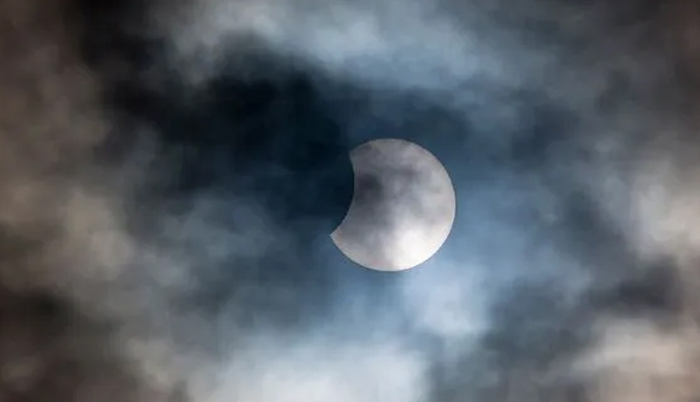![]() Home > Space & Science
Home > Space & Science
'You Could Feel The Energy And Wonder': Despite Clouds, Totality Wows Crowds During Solar Eclipse In Syracuse

The partial phase of the April 8 solar eclipse seen through clouds. (Image credit: Tim Graham/Getty Images)
![]() April 14th, 2024 | 00:32 AM |
April 14th, 2024 | 00:32 AM | ![]() 1291 views
1291 views
SPACE
The total solar eclipse on April 8 plunged Syracuse, New York's Milton J. Rubenstein Museum of Science & Technology into darkness for 90 seconds, creating a wondrous and memorable totality.
Syracuse, N.Y. — On Monday morning (April 8), a crowd began gathering on the lawn of the Milton J. Rubenstein Museum of Science & Technology (MOST), hoping to witness a total solar eclipse.
"I've seen a number of partial [solar] eclipses, but this is my first total eclipse," said Lindsay Hays, a program scientist in the Planetary Science Division at NASA Headquarters. "So I'm very excited for it."
Hays answered questions from eclipse viewers as a part of the museum's Solar Eclipse Festival, which lasted from 12 p.m. to 4 p.m. ET Monday, though many arrived earlier. With free eclipse glasses, a huge eclipse cake and a variety of vendors and food trucks, the event brought a communal eclipse experience to downtown Syracuse's Armory Square. Attendees, including many families with children, stretched out on picnic blankets in the mild weather.
One attendee, Christopher Ducey of Solvay, New York, set up a Cave Astrola telescope from the 1970s on the lawn. The vintage telescope is heavy and bulky by modern standards, Ducey said.
"But I like this old thing, and it easily converts to a really nice projecting solarscope, which is what I'm using it for today," Ducey added. Earlier in the day, the telescope's eyepiece cast a crisp projection of the sun onto a screen behind it, but clouds prevented the solarscope from working later in the day.
Still, the morning's clouds were patchy, and attendees remained optimistic that they might get a glimpse at totality — the moment during a total solar eclipse when the moon completely blocks the sun's disk, plunging the ground below into shadow. If the cloud cover remained light, Hays said, there was a chance that the eclipse itself could cause the clouds to dissipate slightly. The decreased sunlight could limit the evaporation of water into the atmosphere, she said, resulting in fewer clouds forming. Hays said this same effect often causes the sky to clear up slightly during the night.
Hays was even hopeful that the sky might clear up enough to reveal planets, such as Jupiter, near the moon during the sudden darkness of totality.
Like Hays, many at the event were excited to experience totality for the first time.
"It's the most pretty part of it," said Theo, 5, from New York City, showing off the picture he'd drawn of a dark-blue moon rimmed by a pale-yellow corona (the sun's outer atmosphere, which is visible with the naked eye only during totality).
Other attendees were simply excited to be there, pointing to the eclipse as a uniting force in a divided world.
"I'm excited to watch everyone together, especially in such a chaotic time," said Ora Jezer, who was at a booth representing the Central-Northern New York (CNNY) chapter of the Sierra Club, along with her mother, Rhea Jezer, who is the CNNY group chair.
As museum workers announced the start of the partial phase of the eclipse, the sky remained cloudy, with the sun drifting in and out of view. Often, nothing at all was visible through the eclipse glasses. But every few minutes, rays of sunlight shone through the clouds and cheers from onlookers marked each good look at the eclipse.
Just before the start of totality, the clouds dissipated enough to watch the last rays disappear behind the moon. Colors became bizarrely muted, and soon enough, the darkness of evening suddenly swept across the sky.
Unfortunately, the sun's corona wasn't bright enough to pierce the layer of clouds over MOST. But others in Syracuse, including onlookers watching from an event at Syracuse Inner Harbor, were lucky to catch a glimpse of the corona through a gap in the clouds.
Despite the weather, the eerie darkness of totality filled the crowd with awe.
"When the darkness washed over the crowd, you could feel the energy and the wonder that people were experiencing," Emily Stewart, senior director of education and curation at MOST, wrote in a email to Live Science.
After a minute and a half, a single bead of bright, golden light began to emerge from the clouds. The phenomenon, called Baily's beads, happens when sunlight peeks through valleys on the moon's surface. There were more cheers during the sun's reemergence, and the partial views immediately after were some of the clearest of the day.
Though the view of the eclipse from MOST wasn't ideal for viewing totality, Stewart said the experience was still memorable.
"Seeing so many people come out to witness an astronomical event, to hear them cheering and clapping when they saw the eclipse with their own eyes, was so rewarding for our whole team," she said.
Source:
courtesy of SPACE
by Rebecca Sohn
If you have any stories or news that you would like to share with the global online community, please feel free to share it with us by contacting us directly at [email protected]